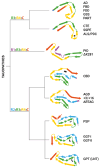Tau and neurodegeneration
- PMID: 38073060
- PMCID: PMC7615684
- DOI: 10.1002/cm.21812
Tau and neurodegeneration
Abstract
First identified in 1975, tau was implicated in Alzheimer's disease 10 years later. Filamentous tangle inclusions were known to be made of hyperphosphorylated tau by 1991, with similar inclusions gaining recognition for being associated with other neurodegenerative diseases. In 1998, mutations in MAPT, the gene that encodes tau, were identified as the cause of a dominantly inherited form of frontotemporal dementia with abundant filamentous tau inclusions. While this result indicated that assembly of tau into aberrant filaments is sufficient to drive neurodegeneration and dementia, most cases of tauopathy are sporadic. More recent work in experimental systems showed that filamentous assemblies of tau may first form in one brain area, and then spread to others in a prion-like fashion. Beginning in 2017, work on human brains using high-resolution techniques has led to a structure-based classification of tauopathies, which has opened the door to a better understanding of the significance of tau filament formation.
Keywords: tau filaments; tau gene mutations; tau isoforms; tauopathies.
© 2023 MRC Laboratory of Molecular Biology and The Authors. Cytoskeleton published by Wiley Periodicals LLC.
Figures



References
-
- Abskharon R, Sawaya MR, Boyer DR, Cao Q, Nguyen BA, Cascio D, Eisenberg DS. Cryo-EM structure of RNA-induced tau fibrils reveals a small C-terminal core that may nucleate fibril formation. Proceedings of the National Academy of Sciences of the United States of America. 2022;119:e2119952119. - PMC - PubMed
-
- Aizawa H, Emori Y, Murofushi H, Kawasaki H, Sakai H, Suzuki K. Molecular cloning of a ubiquitously distributed microtubule-associated protein with Mr 190,000. Journal of Biological Chemistry. 1990;265:13489–13855. - PubMed
-
- Alzheimer A. Über eine eigenartige Erkrankung der Hirnrinde. All-gemeine Zeitschrift für Psychiatrie. 1907;64:146–148.
Publication types
MeSH terms
Substances
Grants and funding
LinkOut - more resources
Full Text Sources

